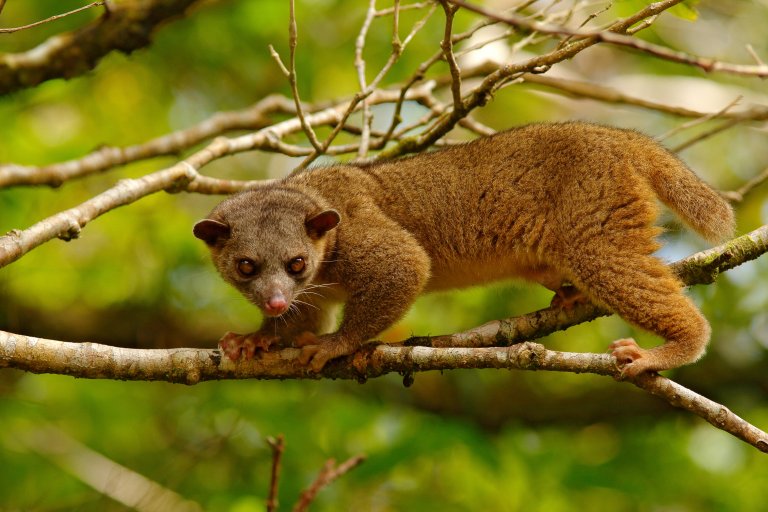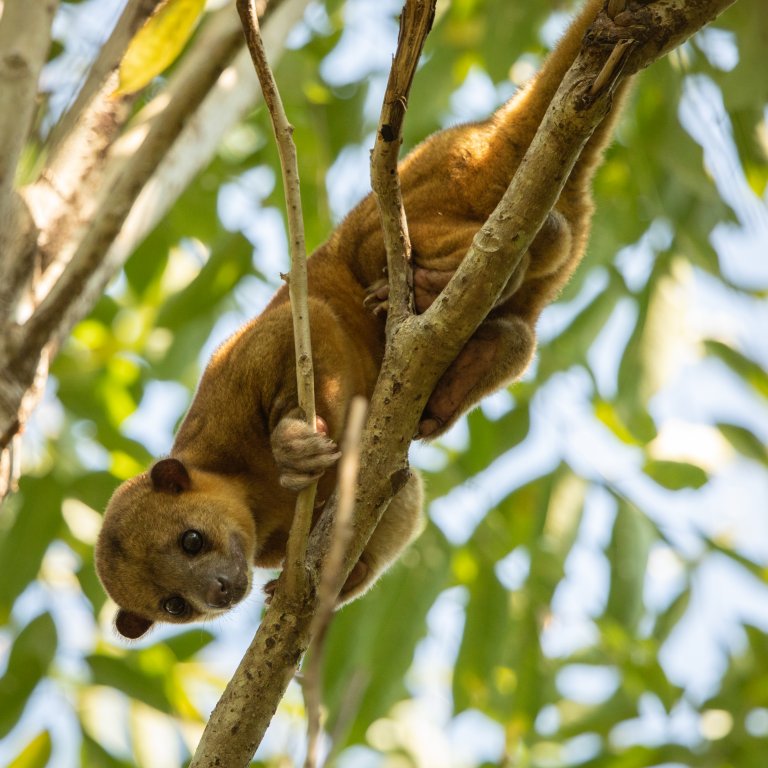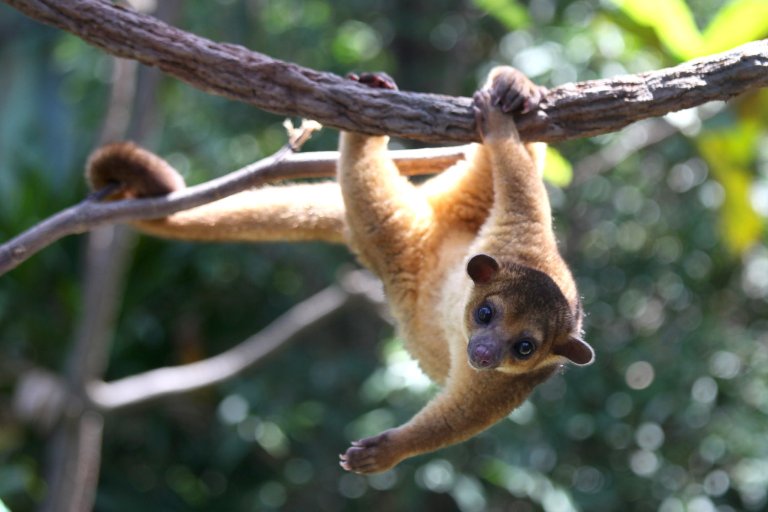Kinkajou Profile
Kinkajou (Potos flavus) are a species of mammals related to raccoons and lemurs. They are best known for their unusual tails and their intelligence.

Kinkajou Facts Overview
| Habitat: | Tropical rainforests |
| Location: | Southern Mexico to Bolivia |
| Lifespan: | Up to 40 years |
| Size: | 81 to 133 cm (about 2.7 to 4.4 ft) for males & 82 to 100 cm (about 2.7 to 3.3 ft) for females |
| Weight: | 1.4 to 4.6 kg (about 3.1 to 10.1 lbs) |
| Appearance: | Rounded head with large eyes and short snout, short limbs, woolly fur, and a long tail |
| Diet: | Fruit, insects, bird eggs |
| Predators: | Jaguars, ocelots, & margays |
| Top Speed: | 20kph |
| No. of Species: |
1 |
| Conservation Status: |
Species of Least Concern |
Kinkajous live in tropical rainforests, where they spend most of their time in trees. The Amazon rainforest in particular is home to large populations of kinkajous.
They travel and forage at night, joining other kinkajous to sleep during the day.
Kinkajous live in the tall branches of trees, where they find food and hide from predators. Although they are able to move on the ground, they quickly return to the treetops when they are hungry, threatened, or tired.
While they are often confused with primates, Kinkajous are in the same family as ringtails, coatis, and racoons.
There are 8 proposed subspecies of kinkajou, which include P. f. chapadensis, P. f. chiriquensis, P. f. flavus, P. f. megalotus, P. f. meridensis, P. f. modestus, P. f. nocturnus, and P. f. prehensilis. Scientists, however, cannot agree on how closely or distantly related these subspecies are or if some are actually the same kind of animal.
They have a number of adaptations that give them unique physical abilities, including a prehensile tail and feet that can turn backwards!
Interesting Kinkajou Facts
1. Their scientific name refers to their sweet tooth
The kinkajou’s scientific name, Potus flavus, means “honey drinker” (direct translation: “drinker of yellow”). This refers to the kinkajou’s tendency to eat honey and other sweet foods.

2. Kinkajous have many different names
This animal’s name comes from the French word quincajou, which itself comes from the Algonquian name for wolverines. Kinkajous are also known as honey bears, night apes, and night walkers. 1
3. They share a name with an unrelated species
Sun bears (Helarctos malayanus) are also called honey bears, but the 2 species are not related.
4. Kinkajous can have long lives
They have been reported to live as long as 40 years in captivity, although they generally live to be about 20 years old.
5. They can make humans sick
They can carry parasites, such as racoon roundworms, and fungal infections that can harm humans. This is one reason why, despite their popularity, kinkajous do not make good pets. 2
6. Kinkajous are strictly nocturnal
This animal spends nearly the entire day sleeping in the trees. After the sun sets, kinkajous begin foraging for food, roaming their territory, and interacting with others.

7. Groups of kinkajous are called troops
Although kinkajous generally prefer to remain alone, they will form small groups that usually contain 1 adult female, her offspring, and 1 or 2 adult males. 3
8. Their diet is almost entirely fruit
Kinkajous are technically omnivores (animals that eat both plant and animal material) and will eat small amounts of insects and eggs. They belong to the order Carnivora and have pointed teeth like animals that eat meat. Almost all of their diet, however, consists of fruit. 4

9. Their waste might serve an important purpose
As the kinkajou digests fruit, it passes seeds and other plant material through its body as waste. The waste provides valuable nutrients, and some of the seeds develop into plants. This leads to plants growing in larger areas than they would have without kinkajous.
10. Kinkajou tongues are very long
They can extend nearly 13 cm (about 5 inches). These long tongues help kinkajous reach inside trees to find food.
11. They have very sensitive hearing
Kinkajous are so good at hearing that they can detect when snakes are slithering toward them!
12. Kinkajous have prehensile tails
This unique physical trait enables kinkajous to use their tails like a fifth hand that can grasp onto branches and tree trunks as the animal climbs.

13. They can turn their feet backwards
Kinkajous can rotate their ankles and feet 180° so they are facing the opposite direction. With their feet facing backwards, kinkajous can rapidly climb up and down tree limbs and trunks.
14. Kinkajous sleep in family groups
A troop of several kinkajous will nest in the same place. They tuck their legs under themselves and curl their tails over their heads before resting.
15. Their eyes reflect yellow and green
Kinkajou eyes appear brown in normal light but reflect yellow and green in the light from flashlights, car headlights, and other sources. This flash of colour is caused by light bouncing off the inside of their eyes.

16. They are very intelligent and love puzzles
In the wild, finding food and exploring keeps kinkajous busy. They have been observed playing tag and play-fighting. In captivity, kinkajous must be given puzzles or other activities or they will destroy their enclosures out of boredom. Some are even reported to have learned how to open cage doors.
Kinkajou Fact-File Summary
Scientific Classification
| Kingdom: | Animalia |
| Phylum: | Chordata |
| Class: | Mammalia |
| Order: | Carnivora |
| Family: | Procyonidae |
| Subfamily: | Potosinae |
| Species Name: |
Potos Flavus |
Fact Sources & References
- Husson Am. The Mammals of Suriname. Brill Archive: 1978.
- Harris JR, Blaney DD, Lindsley MD, et al. Blastomycosis in aan after kinkajou bite. Emerg Infect Dis. 2011;17(2):268-270.
- National Geographic. Kinkajou. Accessed February 5, 2022.
- Lambert JE, Fellner V, McKenney E, Hartstone-Rose A. Binturong (Arctictis binturong) and kinkajou (Potos flavus) digestive strategy: implications for interpreting frugivory in carnivora and primates. PLoS ONE. 2014;9(8):e105415.
